Analysis of Norwegian Aviation Industry
VerifiedAdded on 2021/02/19
|8
|2130
|77
AI Summary
Contribute Materials
Your contribution can guide someone’s learning journey. Share your
documents today.
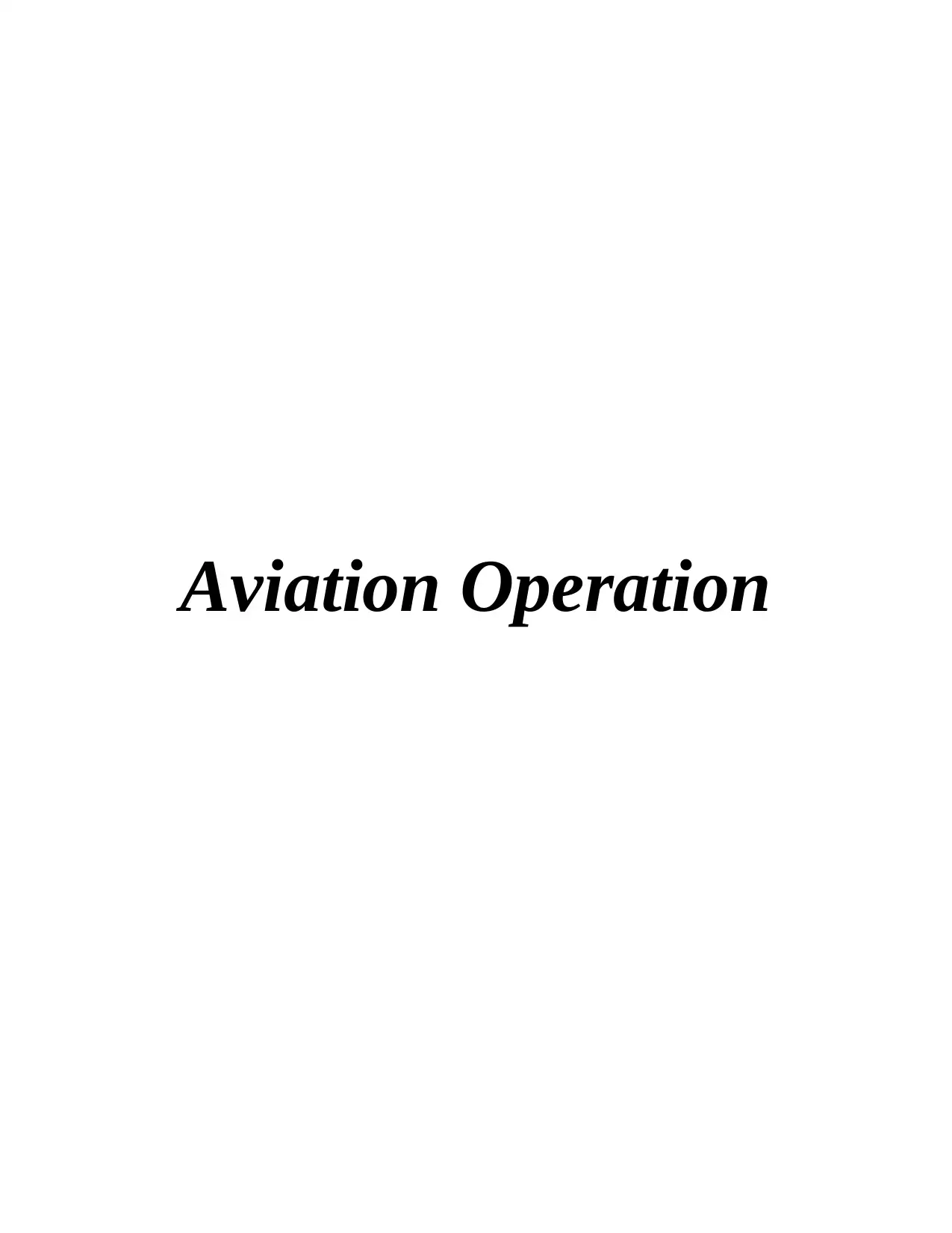
Aviation Operation
Secure Best Marks with AI Grader
Need help grading? Try our AI Grader for instant feedback on your assignments.
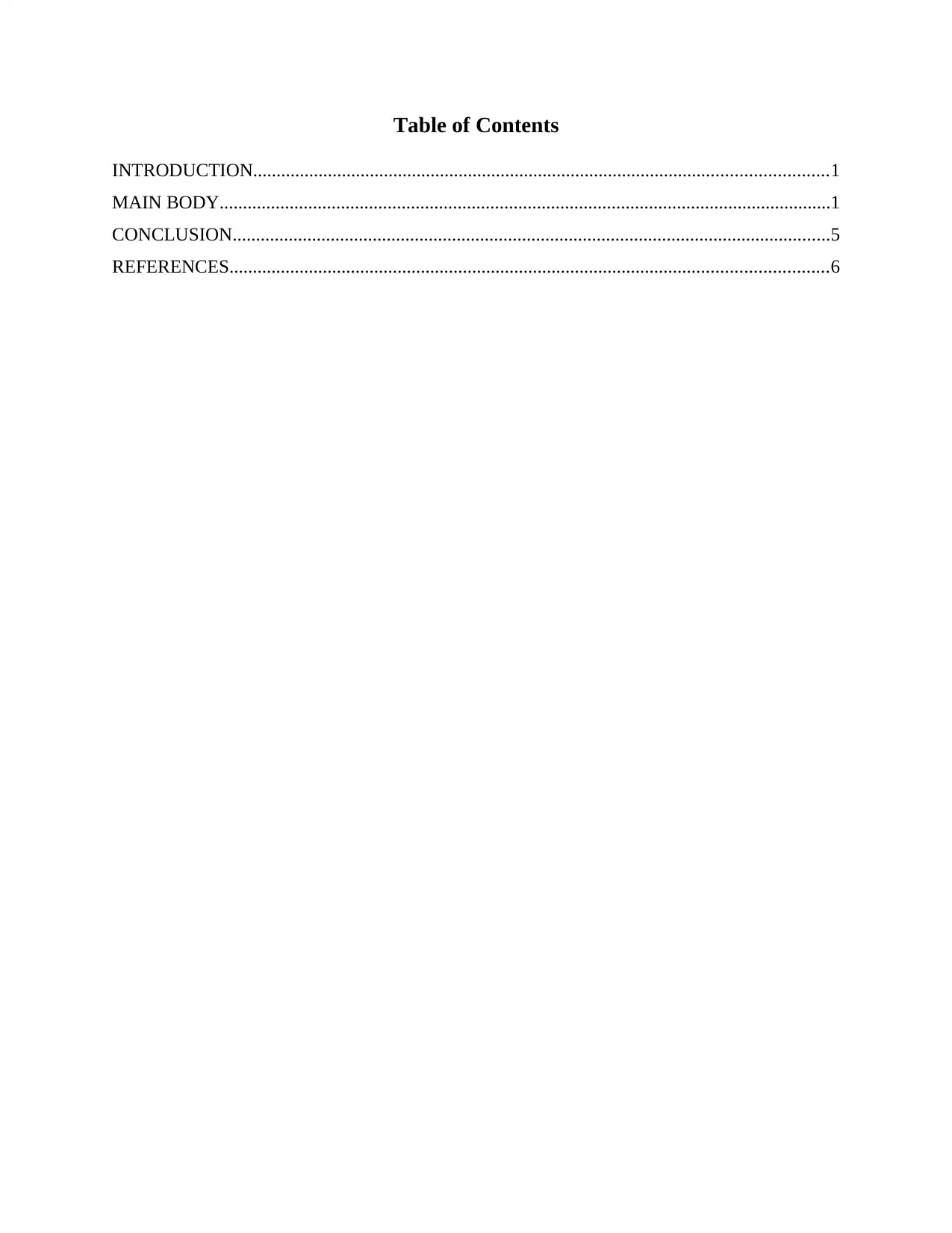
Table of Contents
INTRODUCTION...........................................................................................................................1
MAIN BODY...................................................................................................................................1
CONCLUSION................................................................................................................................5
REFERENCES................................................................................................................................6
INTRODUCTION...........................................................................................................................1
MAIN BODY...................................................................................................................................1
CONCLUSION................................................................................................................................5
REFERENCES................................................................................................................................6
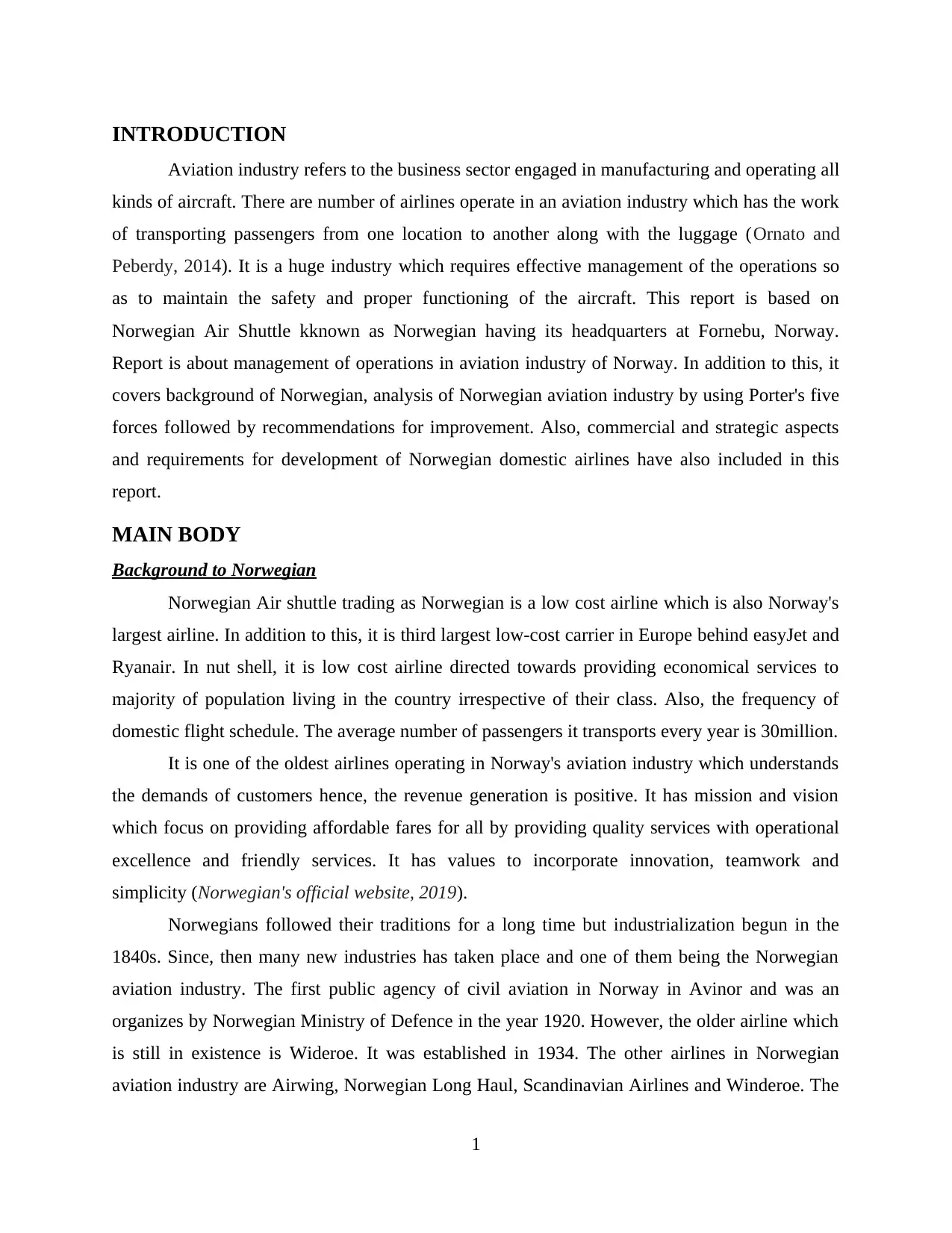
INTRODUCTION
Aviation industry refers to the business sector engaged in manufacturing and operating all
kinds of aircraft. There are number of airlines operate in an aviation industry which has the work
of transporting passengers from one location to another along with the luggage (Ornato and
Peberdy, 2014). It is a huge industry which requires effective management of the operations so
as to maintain the safety and proper functioning of the aircraft. This report is based on
Norwegian Air Shuttle kknown as Norwegian having its headquarters at Fornebu, Norway.
Report is about management of operations in aviation industry of Norway. In addition to this, it
covers background of Norwegian, analysis of Norwegian aviation industry by using Porter's five
forces followed by recommendations for improvement. Also, commercial and strategic aspects
and requirements for development of Norwegian domestic airlines have also included in this
report.
MAIN BODY
Background to Norwegian
Norwegian Air shuttle trading as Norwegian is a low cost airline which is also Norway's
largest airline. In addition to this, it is third largest low-cost carrier in Europe behind easyJet and
Ryanair. In nut shell, it is low cost airline directed towards providing economical services to
majority of population living in the country irrespective of their class. Also, the frequency of
domestic flight schedule. The average number of passengers it transports every year is 30million.
It is one of the oldest airlines operating in Norway's aviation industry which understands
the demands of customers hence, the revenue generation is positive. It has mission and vision
which focus on providing affordable fares for all by providing quality services with operational
excellence and friendly services. It has values to incorporate innovation, teamwork and
simplicity (Norwegian's official website, 2019).
Norwegians followed their traditions for a long time but industrialization begun in the
1840s. Since, then many new industries has taken place and one of them being the Norwegian
aviation industry. The first public agency of civil aviation in Norway in Avinor and was an
organizes by Norwegian Ministry of Defence in the year 1920. However, the older airline which
is still in existence is Wideroe. It was established in 1934. The other airlines in Norwegian
aviation industry are Airwing, Norwegian Long Haul, Scandinavian Airlines and Winderoe. The
1
Aviation industry refers to the business sector engaged in manufacturing and operating all
kinds of aircraft. There are number of airlines operate in an aviation industry which has the work
of transporting passengers from one location to another along with the luggage (Ornato and
Peberdy, 2014). It is a huge industry which requires effective management of the operations so
as to maintain the safety and proper functioning of the aircraft. This report is based on
Norwegian Air Shuttle kknown as Norwegian having its headquarters at Fornebu, Norway.
Report is about management of operations in aviation industry of Norway. In addition to this, it
covers background of Norwegian, analysis of Norwegian aviation industry by using Porter's five
forces followed by recommendations for improvement. Also, commercial and strategic aspects
and requirements for development of Norwegian domestic airlines have also included in this
report.
MAIN BODY
Background to Norwegian
Norwegian Air shuttle trading as Norwegian is a low cost airline which is also Norway's
largest airline. In addition to this, it is third largest low-cost carrier in Europe behind easyJet and
Ryanair. In nut shell, it is low cost airline directed towards providing economical services to
majority of population living in the country irrespective of their class. Also, the frequency of
domestic flight schedule. The average number of passengers it transports every year is 30million.
It is one of the oldest airlines operating in Norway's aviation industry which understands
the demands of customers hence, the revenue generation is positive. It has mission and vision
which focus on providing affordable fares for all by providing quality services with operational
excellence and friendly services. It has values to incorporate innovation, teamwork and
simplicity (Norwegian's official website, 2019).
Norwegians followed their traditions for a long time but industrialization begun in the
1840s. Since, then many new industries has taken place and one of them being the Norwegian
aviation industry. The first public agency of civil aviation in Norway in Avinor and was an
organizes by Norwegian Ministry of Defence in the year 1920. However, the older airline which
is still in existence is Wideroe. It was established in 1934. The other airlines in Norwegian
aviation industry are Airwing, Norwegian Long Haul, Scandinavian Airlines and Winderoe. The
1
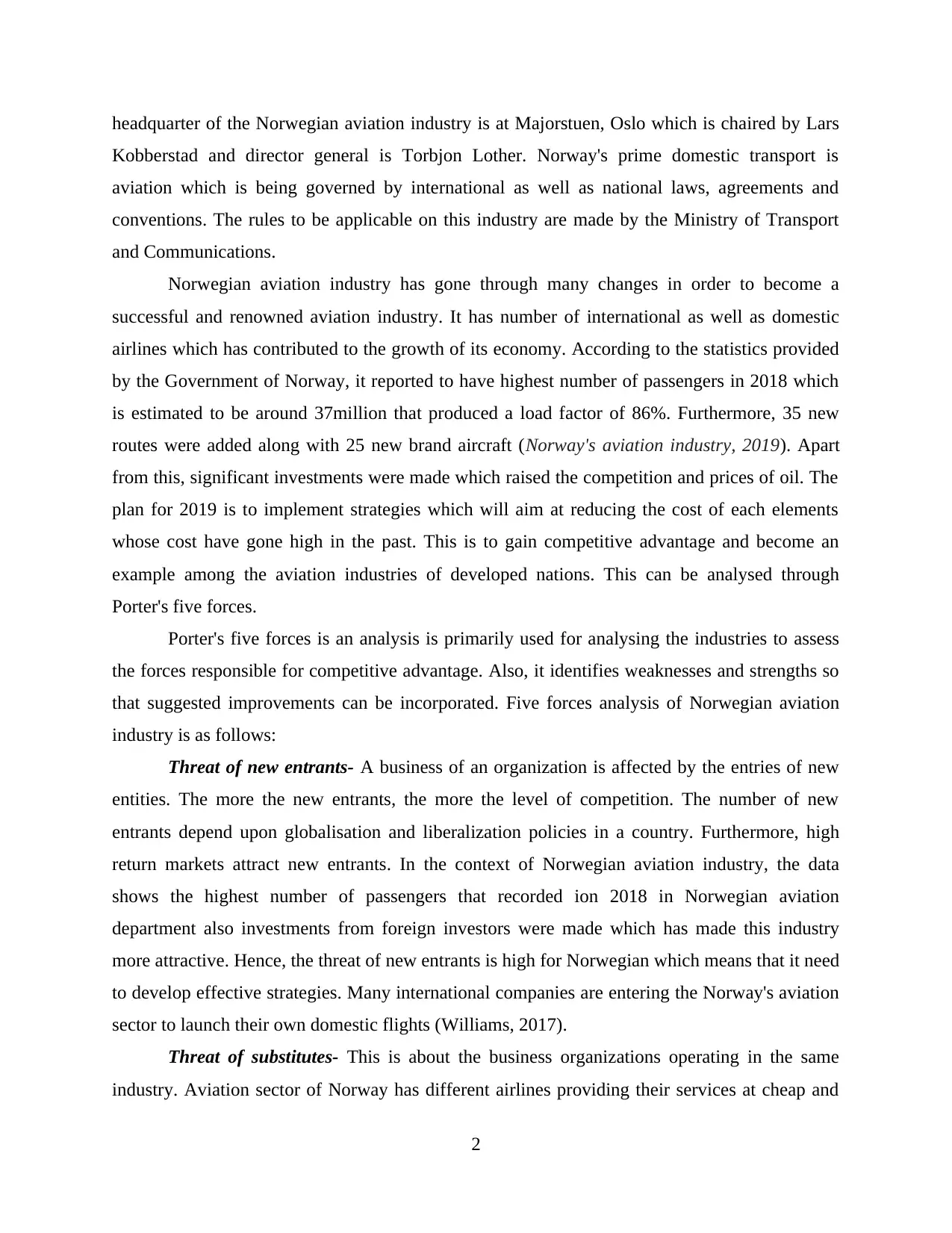
headquarter of the Norwegian aviation industry is at Majorstuen, Oslo which is chaired by Lars
Kobberstad and director general is Torbjon Lother. Norway's prime domestic transport is
aviation which is being governed by international as well as national laws, agreements and
conventions. The rules to be applicable on this industry are made by the Ministry of Transport
and Communications.
Norwegian aviation industry has gone through many changes in order to become a
successful and renowned aviation industry. It has number of international as well as domestic
airlines which has contributed to the growth of its economy. According to the statistics provided
by the Government of Norway, it reported to have highest number of passengers in 2018 which
is estimated to be around 37million that produced a load factor of 86%. Furthermore, 35 new
routes were added along with 25 new brand aircraft (Norway's aviation industry, 2019). Apart
from this, significant investments were made which raised the competition and prices of oil. The
plan for 2019 is to implement strategies which will aim at reducing the cost of each elements
whose cost have gone high in the past. This is to gain competitive advantage and become an
example among the aviation industries of developed nations. This can be analysed through
Porter's five forces.
Porter's five forces is an analysis is primarily used for analysing the industries to assess
the forces responsible for competitive advantage. Also, it identifies weaknesses and strengths so
that suggested improvements can be incorporated. Five forces analysis of Norwegian aviation
industry is as follows:
Threat of new entrants- A business of an organization is affected by the entries of new
entities. The more the new entrants, the more the level of competition. The number of new
entrants depend upon globalisation and liberalization policies in a country. Furthermore, high
return markets attract new entrants. In the context of Norwegian aviation industry, the data
shows the highest number of passengers that recorded ion 2018 in Norwegian aviation
department also investments from foreign investors were made which has made this industry
more attractive. Hence, the threat of new entrants is high for Norwegian which means that it need
to develop effective strategies. Many international companies are entering the Norway's aviation
sector to launch their own domestic flights (Williams, 2017).
Threat of substitutes- This is about the business organizations operating in the same
industry. Aviation sector of Norway has different airlines providing their services at cheap and
2
Kobberstad and director general is Torbjon Lother. Norway's prime domestic transport is
aviation which is being governed by international as well as national laws, agreements and
conventions. The rules to be applicable on this industry are made by the Ministry of Transport
and Communications.
Norwegian aviation industry has gone through many changes in order to become a
successful and renowned aviation industry. It has number of international as well as domestic
airlines which has contributed to the growth of its economy. According to the statistics provided
by the Government of Norway, it reported to have highest number of passengers in 2018 which
is estimated to be around 37million that produced a load factor of 86%. Furthermore, 35 new
routes were added along with 25 new brand aircraft (Norway's aviation industry, 2019). Apart
from this, significant investments were made which raised the competition and prices of oil. The
plan for 2019 is to implement strategies which will aim at reducing the cost of each elements
whose cost have gone high in the past. This is to gain competitive advantage and become an
example among the aviation industries of developed nations. This can be analysed through
Porter's five forces.
Porter's five forces is an analysis is primarily used for analysing the industries to assess
the forces responsible for competitive advantage. Also, it identifies weaknesses and strengths so
that suggested improvements can be incorporated. Five forces analysis of Norwegian aviation
industry is as follows:
Threat of new entrants- A business of an organization is affected by the entries of new
entities. The more the new entrants, the more the level of competition. The number of new
entrants depend upon globalisation and liberalization policies in a country. Furthermore, high
return markets attract new entrants. In the context of Norwegian aviation industry, the data
shows the highest number of passengers that recorded ion 2018 in Norwegian aviation
department also investments from foreign investors were made which has made this industry
more attractive. Hence, the threat of new entrants is high for Norwegian which means that it need
to develop effective strategies. Many international companies are entering the Norway's aviation
sector to launch their own domestic flights (Williams, 2017).
Threat of substitutes- This is about the business organizations operating in the same
industry. Aviation sector of Norway has different airlines providing their services at cheap and
2
Secure Best Marks with AI Grader
Need help grading? Try our AI Grader for instant feedback on your assignments.
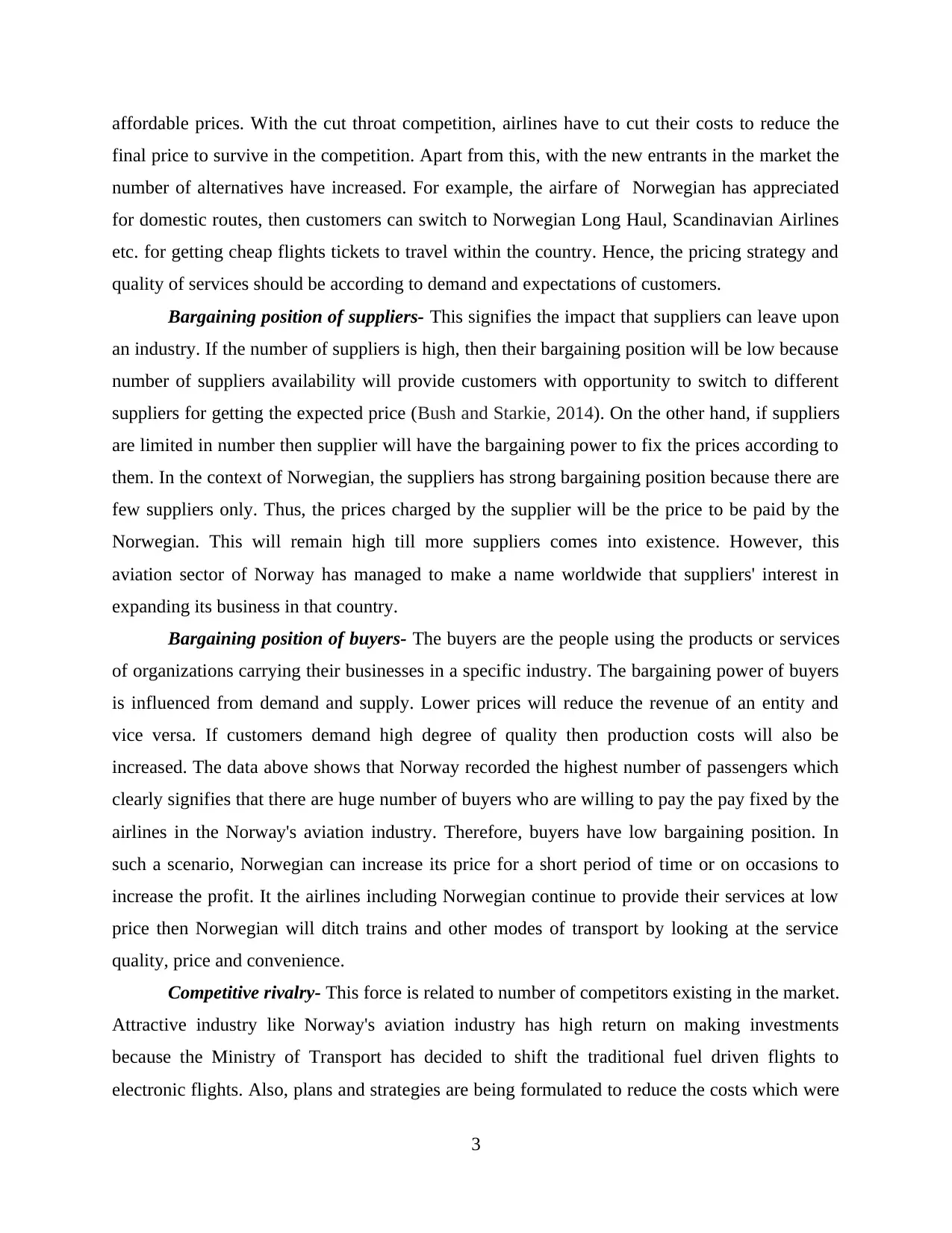
affordable prices. With the cut throat competition, airlines have to cut their costs to reduce the
final price to survive in the competition. Apart from this, with the new entrants in the market the
number of alternatives have increased. For example, the airfare of Norwegian has appreciated
for domestic routes, then customers can switch to Norwegian Long Haul, Scandinavian Airlines
etc. for getting cheap flights tickets to travel within the country. Hence, the pricing strategy and
quality of services should be according to demand and expectations of customers.
Bargaining position of suppliers- This signifies the impact that suppliers can leave upon
an industry. If the number of suppliers is high, then their bargaining position will be low because
number of suppliers availability will provide customers with opportunity to switch to different
suppliers for getting the expected price (Bush and Starkie, 2014). On the other hand, if suppliers
are limited in number then supplier will have the bargaining power to fix the prices according to
them. In the context of Norwegian, the suppliers has strong bargaining position because there are
few suppliers only. Thus, the prices charged by the supplier will be the price to be paid by the
Norwegian. This will remain high till more suppliers comes into existence. However, this
aviation sector of Norway has managed to make a name worldwide that suppliers' interest in
expanding its business in that country.
Bargaining position of buyers- The buyers are the people using the products or services
of organizations carrying their businesses in a specific industry. The bargaining power of buyers
is influenced from demand and supply. Lower prices will reduce the revenue of an entity and
vice versa. If customers demand high degree of quality then production costs will also be
increased. The data above shows that Norway recorded the highest number of passengers which
clearly signifies that there are huge number of buyers who are willing to pay the pay fixed by the
airlines in the Norway's aviation industry. Therefore, buyers have low bargaining position. In
such a scenario, Norwegian can increase its price for a short period of time or on occasions to
increase the profit. It the airlines including Norwegian continue to provide their services at low
price then Norwegian will ditch trains and other modes of transport by looking at the service
quality, price and convenience.
Competitive rivalry- This force is related to number of competitors existing in the market.
Attractive industry like Norway's aviation industry has high return on making investments
because the Ministry of Transport has decided to shift the traditional fuel driven flights to
electronic flights. Also, plans and strategies are being formulated to reduce the costs which were
3
final price to survive in the competition. Apart from this, with the new entrants in the market the
number of alternatives have increased. For example, the airfare of Norwegian has appreciated
for domestic routes, then customers can switch to Norwegian Long Haul, Scandinavian Airlines
etc. for getting cheap flights tickets to travel within the country. Hence, the pricing strategy and
quality of services should be according to demand and expectations of customers.
Bargaining position of suppliers- This signifies the impact that suppliers can leave upon
an industry. If the number of suppliers is high, then their bargaining position will be low because
number of suppliers availability will provide customers with opportunity to switch to different
suppliers for getting the expected price (Bush and Starkie, 2014). On the other hand, if suppliers
are limited in number then supplier will have the bargaining power to fix the prices according to
them. In the context of Norwegian, the suppliers has strong bargaining position because there are
few suppliers only. Thus, the prices charged by the supplier will be the price to be paid by the
Norwegian. This will remain high till more suppliers comes into existence. However, this
aviation sector of Norway has managed to make a name worldwide that suppliers' interest in
expanding its business in that country.
Bargaining position of buyers- The buyers are the people using the products or services
of organizations carrying their businesses in a specific industry. The bargaining power of buyers
is influenced from demand and supply. Lower prices will reduce the revenue of an entity and
vice versa. If customers demand high degree of quality then production costs will also be
increased. The data above shows that Norway recorded the highest number of passengers which
clearly signifies that there are huge number of buyers who are willing to pay the pay fixed by the
airlines in the Norway's aviation industry. Therefore, buyers have low bargaining position. In
such a scenario, Norwegian can increase its price for a short period of time or on occasions to
increase the profit. It the airlines including Norwegian continue to provide their services at low
price then Norwegian will ditch trains and other modes of transport by looking at the service
quality, price and convenience.
Competitive rivalry- This force is related to number of competitors existing in the market.
Attractive industry like Norway's aviation industry has high return on making investments
because the Ministry of Transport has decided to shift the traditional fuel driven flights to
electronic flights. Also, plans and strategies are being formulated to reduce the costs which were
3
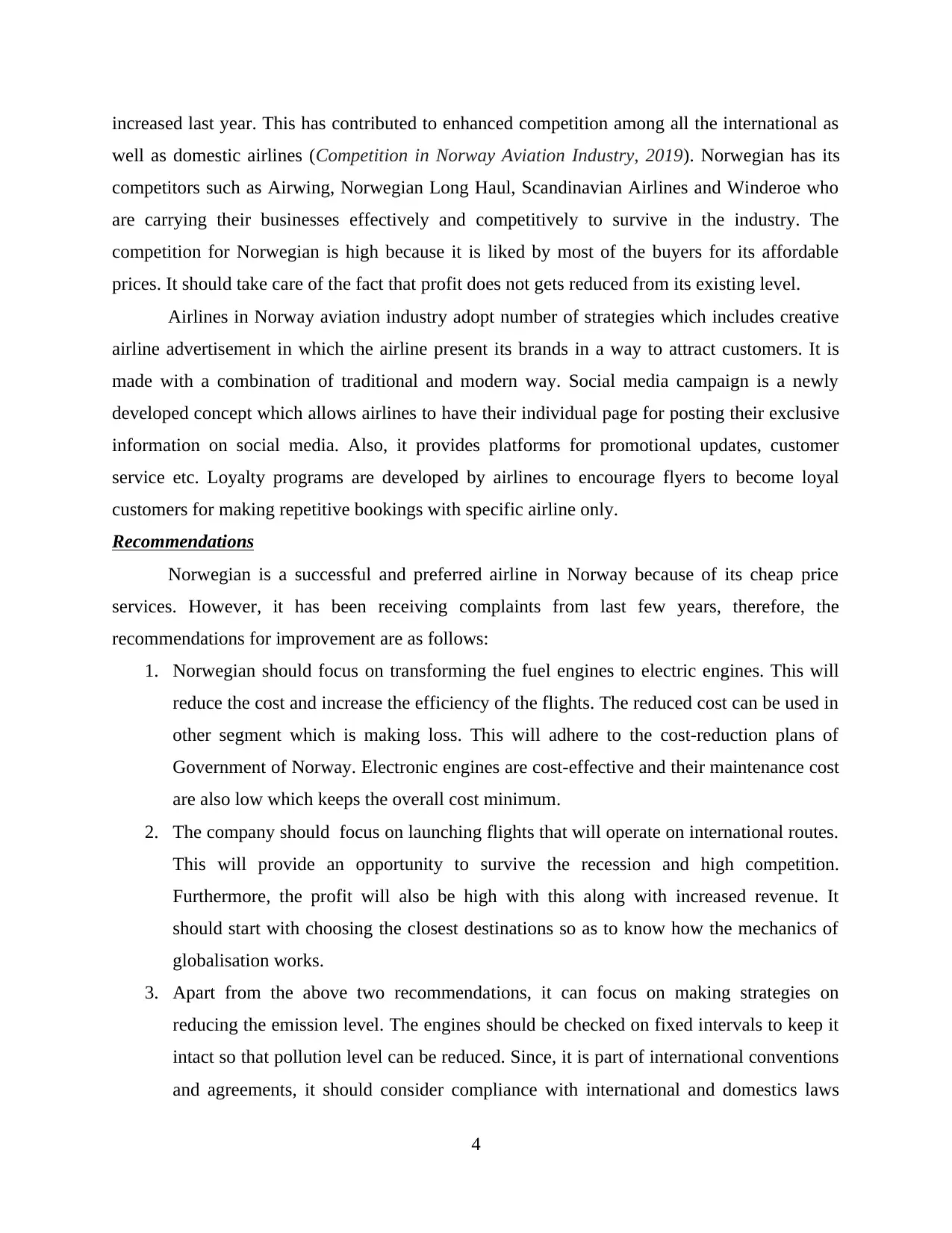
increased last year. This has contributed to enhanced competition among all the international as
well as domestic airlines (Competition in Norway Aviation Industry, 2019). Norwegian has its
competitors such as Airwing, Norwegian Long Haul, Scandinavian Airlines and Winderoe who
are carrying their businesses effectively and competitively to survive in the industry. The
competition for Norwegian is high because it is liked by most of the buyers for its affordable
prices. It should take care of the fact that profit does not gets reduced from its existing level.
Airlines in Norway aviation industry adopt number of strategies which includes creative
airline advertisement in which the airline present its brands in a way to attract customers. It is
made with a combination of traditional and modern way. Social media campaign is a newly
developed concept which allows airlines to have their individual page for posting their exclusive
information on social media. Also, it provides platforms for promotional updates, customer
service etc. Loyalty programs are developed by airlines to encourage flyers to become loyal
customers for making repetitive bookings with specific airline only.
Recommendations
Norwegian is a successful and preferred airline in Norway because of its cheap price
services. However, it has been receiving complaints from last few years, therefore, the
recommendations for improvement are as follows:
1. Norwegian should focus on transforming the fuel engines to electric engines. This will
reduce the cost and increase the efficiency of the flights. The reduced cost can be used in
other segment which is making loss. This will adhere to the cost-reduction plans of
Government of Norway. Electronic engines are cost-effective and their maintenance cost
are also low which keeps the overall cost minimum.
2. The company should focus on launching flights that will operate on international routes.
This will provide an opportunity to survive the recession and high competition.
Furthermore, the profit will also be high with this along with increased revenue. It
should start with choosing the closest destinations so as to know how the mechanics of
globalisation works.
3. Apart from the above two recommendations, it can focus on making strategies on
reducing the emission level. The engines should be checked on fixed intervals to keep it
intact so that pollution level can be reduced. Since, it is part of international conventions
and agreements, it should consider compliance with international and domestics laws
4
well as domestic airlines (Competition in Norway Aviation Industry, 2019). Norwegian has its
competitors such as Airwing, Norwegian Long Haul, Scandinavian Airlines and Winderoe who
are carrying their businesses effectively and competitively to survive in the industry. The
competition for Norwegian is high because it is liked by most of the buyers for its affordable
prices. It should take care of the fact that profit does not gets reduced from its existing level.
Airlines in Norway aviation industry adopt number of strategies which includes creative
airline advertisement in which the airline present its brands in a way to attract customers. It is
made with a combination of traditional and modern way. Social media campaign is a newly
developed concept which allows airlines to have their individual page for posting their exclusive
information on social media. Also, it provides platforms for promotional updates, customer
service etc. Loyalty programs are developed by airlines to encourage flyers to become loyal
customers for making repetitive bookings with specific airline only.
Recommendations
Norwegian is a successful and preferred airline in Norway because of its cheap price
services. However, it has been receiving complaints from last few years, therefore, the
recommendations for improvement are as follows:
1. Norwegian should focus on transforming the fuel engines to electric engines. This will
reduce the cost and increase the efficiency of the flights. The reduced cost can be used in
other segment which is making loss. This will adhere to the cost-reduction plans of
Government of Norway. Electronic engines are cost-effective and their maintenance cost
are also low which keeps the overall cost minimum.
2. The company should focus on launching flights that will operate on international routes.
This will provide an opportunity to survive the recession and high competition.
Furthermore, the profit will also be high with this along with increased revenue. It
should start with choosing the closest destinations so as to know how the mechanics of
globalisation works.
3. Apart from the above two recommendations, it can focus on making strategies on
reducing the emission level. The engines should be checked on fixed intervals to keep it
intact so that pollution level can be reduced. Since, it is part of international conventions
and agreements, it should consider compliance with international and domestics laws
4
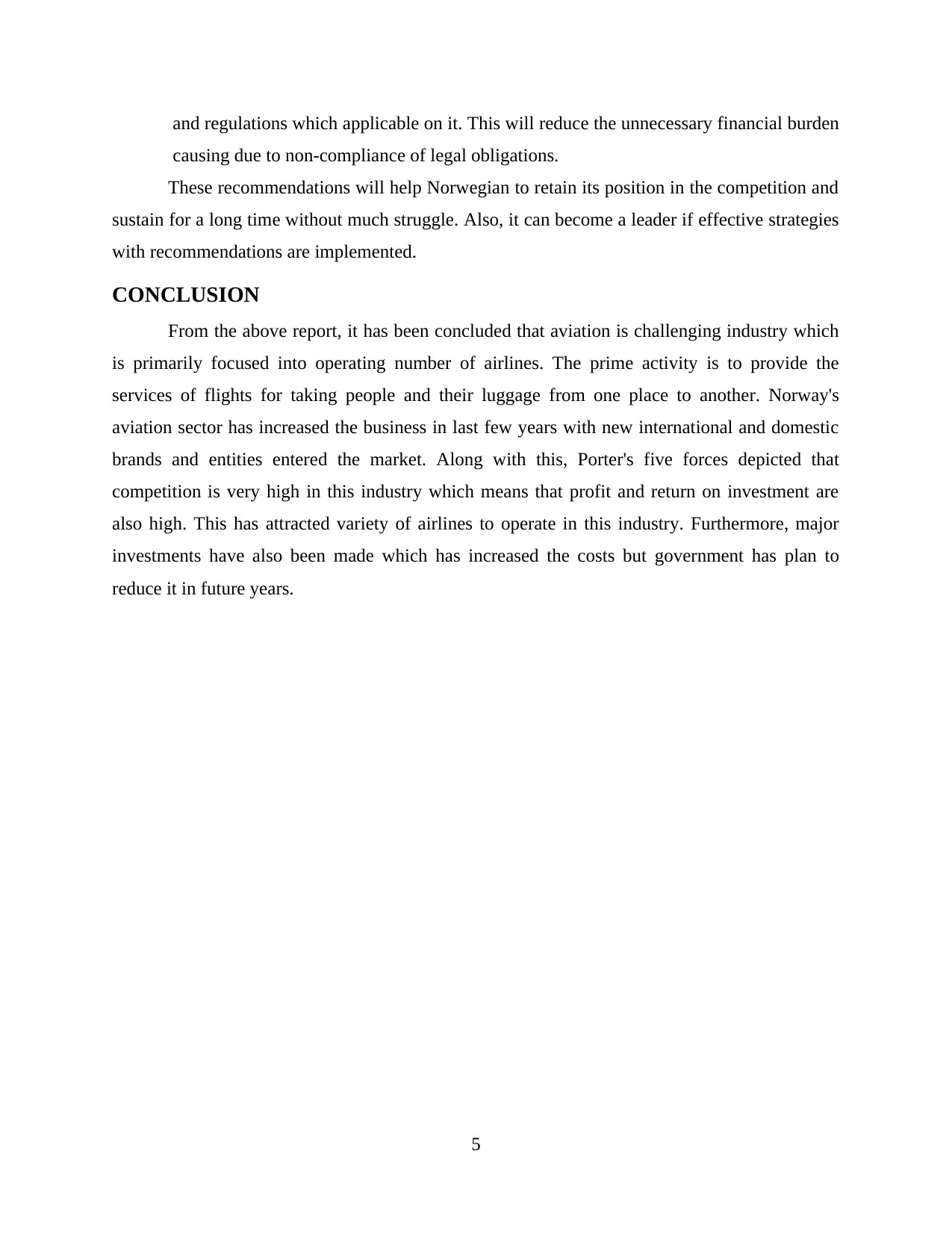
and regulations which applicable on it. This will reduce the unnecessary financial burden
causing due to non-compliance of legal obligations.
These recommendations will help Norwegian to retain its position in the competition and
sustain for a long time without much struggle. Also, it can become a leader if effective strategies
with recommendations are implemented.
CONCLUSION
From the above report, it has been concluded that aviation is challenging industry which
is primarily focused into operating number of airlines. The prime activity is to provide the
services of flights for taking people and their luggage from one place to another. Norway's
aviation sector has increased the business in last few years with new international and domestic
brands and entities entered the market. Along with this, Porter's five forces depicted that
competition is very high in this industry which means that profit and return on investment are
also high. This has attracted variety of airlines to operate in this industry. Furthermore, major
investments have also been made which has increased the costs but government has plan to
reduce it in future years.
5
causing due to non-compliance of legal obligations.
These recommendations will help Norwegian to retain its position in the competition and
sustain for a long time without much struggle. Also, it can become a leader if effective strategies
with recommendations are implemented.
CONCLUSION
From the above report, it has been concluded that aviation is challenging industry which
is primarily focused into operating number of airlines. The prime activity is to provide the
services of flights for taking people and their luggage from one place to another. Norway's
aviation sector has increased the business in last few years with new international and domestic
brands and entities entered the market. Along with this, Porter's five forces depicted that
competition is very high in this industry which means that profit and return on investment are
also high. This has attracted variety of airlines to operate in this industry. Furthermore, major
investments have also been made which has increased the costs but government has plan to
reduce it in future years.
5
Paraphrase This Document
Need a fresh take? Get an instant paraphrase of this document with our AI Paraphraser
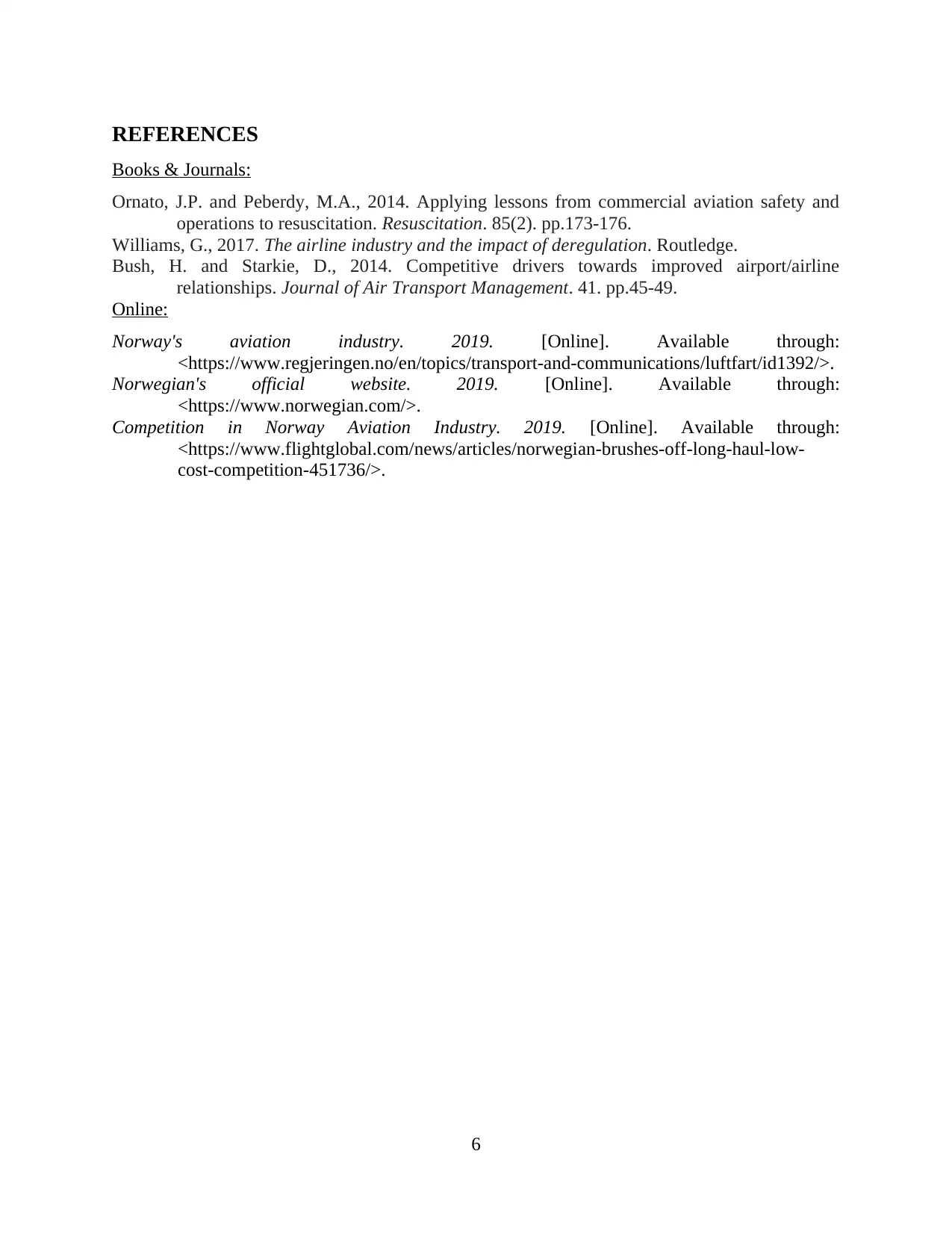
REFERENCES
Books & Journals:
Ornato, J.P. and Peberdy, M.A., 2014. Applying lessons from commercial aviation safety and
operations to resuscitation. Resuscitation. 85(2). pp.173-176.
Williams, G., 2017. The airline industry and the impact of deregulation. Routledge.
Bush, H. and Starkie, D., 2014. Competitive drivers towards improved airport/airline
relationships. Journal of Air Transport Management. 41. pp.45-49.
Online:
Norway's aviation industry. 2019. [Online]. Available through:
<https://www.regjeringen.no/en/topics/transport-and-communications/luftfart/id1392/>.
Norwegian's official website. 2019. [Online]. Available through:
<https://www.norwegian.com/>.
Competition in Norway Aviation Industry. 2019. [Online]. Available through:
<https://www.flightglobal.com/news/articles/norwegian-brushes-off-long-haul-low-
cost-competition-451736/>.
6
Books & Journals:
Ornato, J.P. and Peberdy, M.A., 2014. Applying lessons from commercial aviation safety and
operations to resuscitation. Resuscitation. 85(2). pp.173-176.
Williams, G., 2017. The airline industry and the impact of deregulation. Routledge.
Bush, H. and Starkie, D., 2014. Competitive drivers towards improved airport/airline
relationships. Journal of Air Transport Management. 41. pp.45-49.
Online:
Norway's aviation industry. 2019. [Online]. Available through:
<https://www.regjeringen.no/en/topics/transport-and-communications/luftfart/id1392/>.
Norwegian's official website. 2019. [Online]. Available through:
<https://www.norwegian.com/>.
Competition in Norway Aviation Industry. 2019. [Online]. Available through:
<https://www.flightglobal.com/news/articles/norwegian-brushes-off-long-haul-low-
cost-competition-451736/>.
6
1 out of 8
Related Documents
Your All-in-One AI-Powered Toolkit for Academic Success.
+13062052269
info@desklib.com
Available 24*7 on WhatsApp / Email
![[object Object]](/_next/static/media/star-bottom.7253800d.svg)
Unlock your academic potential
© 2024 | Zucol Services PVT LTD | All rights reserved.





